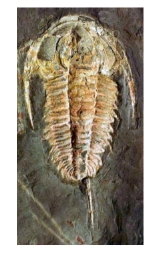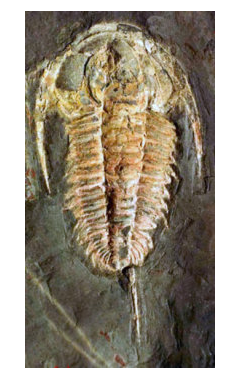
Emu Bay shale
Encyclopedia

Lagerstätte
A Lagerstätte is a sedimentary deposit that exhibits extraordinary fossil richness or completeness.Palaeontologists distinguish two kinds....
n (fossil beds with soft tissue preservation). It is one of two in the world containing Redlichiida
Redlichiida
Redlichiida is an order within the major extinct arthropod class Trilobita. The Redlichids are one of the four older classes of trilobites that originated in the Lower Cambrian....
n trilobite
Trilobite
Trilobites are a well-known fossil group of extinct marine arthropods that form the class Trilobita. The first appearance of trilobites in the fossil record defines the base of the Atdabanian stage of the Early Cambrian period , and they flourished throughout the lower Paleozoic era before...
s. The Australian's Emu Bay Shale correlated with upper Botomian Stage of the Lower Cambrian.
Its mode of preservation is the same as
Burgess shale type preservation
The Burgess Shale of British Columbia is famous for its exceptional preservation of mid-Cambrian organisms. Around 40 other sites have been discovered of a similar age, with soft tissues preserved in a similar, though not identical, fashion...
the Burgess shale
Burgess Shale
The Burgess Shale Formation, located in the Canadian Rockies of British Columbia, is one of the world's most celebrated fossil fields, and the best of its kind. It is famous for the exceptional preservation of the soft parts of its fossils...
, but the larger grain size of the Emu Bay rock means that the quality of preservation is lower.
Description
The Emu Bay Shale of Kangaroo IslandKangaroo Island
Kangaroo Island is Australia's third-largest island after Tasmania and Melville Island. It is southwest of Adelaide at the entrance of Gulf St Vincent. Its closest point to the mainland is off Cape Jervis, on the tip of the Fleurieu Peninsula in the state of South Australia. The island is long...
, South Australia
South Australia
South Australia is a state of Australia in the southern central part of the country. It covers some of the most arid parts of the continent; with a total land area of , it is the fourth largest of Australia's six states and two territories.South Australia shares borders with all of the mainland...
, is Australia
Australia
Australia , officially the Commonwealth of Australia, is a country in the Southern Hemisphere comprising the mainland of the Australian continent, the island of Tasmania, and numerous smaller islands in the Indian and Pacific Oceans. It is the world's sixth-largest country by total area...
's only known Burgess-Shale-type
Burgess Shale
The Burgess Shale Formation, located in the Canadian Rockies of British Columbia, is one of the world's most celebrated fossil fields, and the best of its kind. It is famous for the exceptional preservation of the soft parts of its fossils...
Konservat-Lagerstätte
Lagerstätte
A Lagerstätte is a sedimentary deposit that exhibits extraordinary fossil richness or completeness.Palaeontologists distinguish two kinds....
, and includes faunal elements such as Anomalocaris
Anomalocarid
AnomalocarididsNeolatin compound word from Greek ἀνώμαλος anomalos and καρίς karis , meaning "strange shrimp". Note that while "Anomalocarid" is a widely used alternative spelling, the double "id" at the end is technically the correct form, for the reasons given in...
, Tuzoia
Tuzoia
Tuzoia is a large bivalved arthropod known from the Burgess Shale, British Columbia, and Kaili . This arthropod reached lengths of 180 mm long. There are currently 7 valid species recognized....
, Isoxys
Isoxys
Isoxys was a bivalved arthropod, which was probably a free-swimming predator. It had a large pair of spherical eyes , and two large appendages, which have led to speculation that it may be related to the great appendage arthropods.- Ecology :It was abundant in tropical seas, and may have had a global...
, Xandarella, and Primicaris, in common with other Burgess-Shale-type assemblages, particularly the Chengjiang
Maotianshan shales
The Maotianshan Shales are a series of lower Cambrian deposits in the Chiungchussu formation, famous for their Konservat Lagerstätten, or high number of fossils preserved in place...
Fauna in China, the closest palaeogeographically, although somewhat older. The site is also the source of magnificent specimens of trilobite
Trilobite
Trilobites are a well-known fossil group of extinct marine arthropods that form the class Trilobita. The first appearance of trilobites in the fossil record defines the base of the Atdabanian stage of the Early Cambrian period , and they flourished throughout the lower Paleozoic era before...
s such as Redlichia takooensis
Redlichia takooensis
Redlichia takooensis is a species of trilobite from the lower Cambrian period. Their fossils are found chiefly in Australia....
, Emuella polymera
Emuella polymera
Emuella polymera is a species of trilobite from the lower Cambrian period. Their fossils are found chiefly in Australia....
, Balcoracania dailyi
Balcoracania dailyi
Balcoracania dailyi is a species of trilobite from the lower Cambrian period. Their fossils are found chiefly in Australia....
, and Estaingia (=Hsuaspis) bilobata
Estaingia bilobata
Estaingia bilobata is a species of trilobite from the lower Cambrian period. Their fossils are found chiefly in Australia....
. Balcoracania
Balcoracania
Balcoracania is a genus of trilobite of the family Emuellidae. Their fossils are found chiefly in Australia....
and Emuella
Emuella
Emuella is a genus of trilobites of the family Emuellidae. Their fossils are found chiefly in Lower Cambrian strata of Australia....
are genera of the distinctive Redlichiina
Redlichiina
Redlichiina is a suborder of the order Redlichiida of Trilobites. The suborder contains three superfamilies: Emuelloidea, Redlichioidea and Paradoxidoidea. These trilobites are some of the oldest trilobites known...
superfamily Emuelloidea, known for numerous segments (over 60 in large Balcoracania specimens), and so far entirely restricted to Australia.
The depositional environment
Sedimentary depositional environment
In geology, sedimentary depositional environment describes the combination of physical, chemical and biological processes associated with the deposition of a particular type of sediment and, therefore, the rock types that will be formed after lithification, if the sediment is preserved in the rock...
of the majority of Burgess-Shale-type assemblages is outer shelf, deeper water. The Emu Bay Shale in contrast, appears to represent relatively shallow water deposition, indicating that soft tissue preservation occurred in a range of environmental settings during the Cambrian. Some Emu Bay fossils display extensive mineralization of soft tissues, most often of blocky apatite
Apatite
Apatite is a group of phosphate minerals, usually referring to hydroxylapatite, fluorapatite, chlorapatite and bromapatite, named for high concentrations of OH−, F−, Cl− or Br− ions, respectively, in the crystal...
or fibrous calcium carbonate
Calcium carbonate
Calcium carbonate is a chemical compound with the formula CaCO3. It is a common substance found in rocks in all parts of the world, and is the main component of shells of marine organisms, snails, coal balls, pearls, and eggshells. Calcium carbonate is the active ingredient in agricultural lime,...
, including the oldest phosphatized muscle tissue – the first thus far reported from the Cambrian
Cambrian
The Cambrian is the first geological period of the Paleozoic Era, lasting from Mya ; it is succeeded by the Ordovician. Its subdivisions, and indeed its base, are somewhat in flux. The period was established by Adam Sedgwick, who named it after Cambria, the Latin name for Wales, where Britain's...
. Mineralized soft tissues are apparently rare among Burgess-Shale-type biotas.
The type section of the Emu Bay Shale crops out on the east side of Emu Bay where it conformably overlies the White Point Conglomerate. Here it yields a rich assemblage of Hsuaspis, Redlichia, hyolithids
Hyolitha
Hyolitha are enigmatic animals with small conical shells known from the Palaeozoic Era.-Shell morphology:The calcareous shells have a cover and two curved supports known as helens. Most are one to four centimeters in length and are triangular or elliptical in cross section...
, brachiopod
Brachiopod
Brachiopods are a phylum of marine animals that have hard "valves" on the upper and lower surfaces, unlike the left and right arrangement in bivalve molluscs. Brachiopod valves are hinged at the rear end, while the front can be opened for feeding or closed for protection...
s, and the scleritome
Sclerite
A sclerite is a hardened body part. The term is used in various branches of biology for various structures including hardened portions of sponges, but it is most commonly used for the hardened portions of arthropod exoskeletons....
-bearing Chancelloria
Chancelloria
Chancelloria is a genus of early animal known from the Middle Cambrian Burgess Shale, the Comley limestone, the Wheeler Shale,, the Bright Angel Shale and elsewhere. It was first described in 1920 by Charles Doolittle Walcott, who regarded them as one of the most primitive groups of sponges...
. At the Big Gully locality (8 km east of White Point), its presumed correlative is unconformable on the White Point Conglomerate and yields soft-bodied fossils in addition to the trilobites, including the giant predator Anomalocaris, Isoxys, Tuzoia, the presumed worm Palaeoscolex, the problematic Myoscolex
Myoscolex
Myoscolex is a problematic fossil from the Cambrian Emu Bay Shale that, originally interpreted as an annelid, seems to be an arthropod; the possible presence of an Opabinia-like nozzle suggests a plausible relationship with that animal....
, and a number of rarer elements. The Big Gully trilobites rarely preserve any trace of non-biomineralized tissue; a small number of specimens of Redlichia have been reported with antennae.
See also
- LagerstätteLagerstätteA Lagerstätte is a sedimentary deposit that exhibits extraordinary fossil richness or completeness.Palaeontologists distinguish two kinds....
- other fossil localities - List of fossil sites (with link directory)

